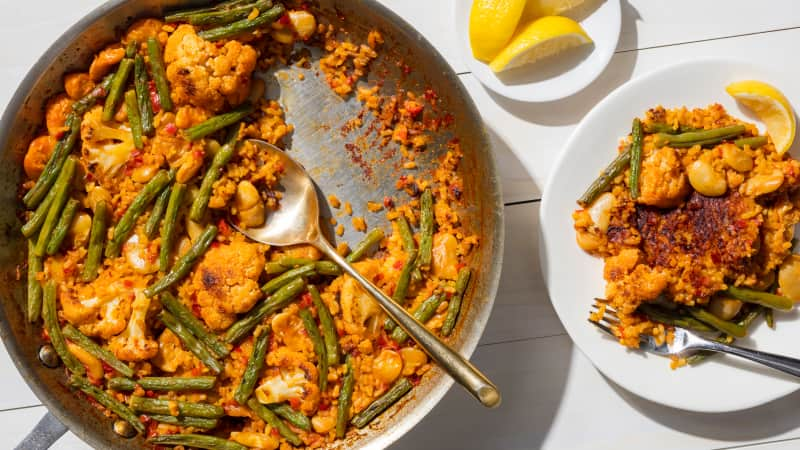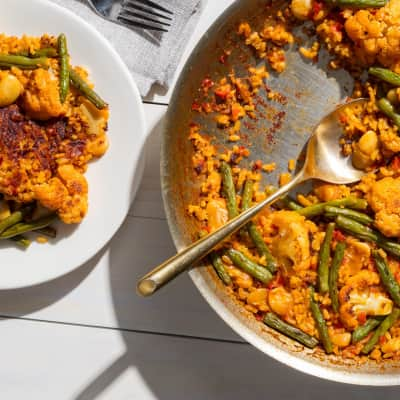I’ve loved paella ever since I had my first forkful, but I can’t say I’m loyal to any particular version. I’m just as eager to tuck into the Valencian classic, studded with snails and rabbit and garrofón (the broad, white shell bean native to the region), as I am a surf-and-turf paella mixta or a dramatic arroz a la marinera teeming with shellfish. To me, the plump, chewy, sofrito-infused grains are the ultimate foundation for just about any addition—and I can’t help but think that Spanish rice farmers had the same idea centuries ago, when they cobbled together paella prototypes from their harvest and whatever bits of meat and vegetables were available.
Savory, Satisfying Paella de Verduras
Published June 1, 2021.

That flexibility is even more evident in paella de verduras. Showcasing vegetables, rather than merely using them to flavor the rice, is a common, if less established, approach to the dish, and it can go in countless directions based on locally available produce and personal taste. With a thoughtful mix of vegetables, the results can be just as eye-catching and satisfying as any protein-based version.
But there’s one critical element of a meat-based paella that’s hard to capture in a vegetable version: the deeply savory fond created by browning the protein. Making great paella is fundamentally about flavoring the rice, and that meaty backbone—along with the sofrito and other seasonings—is largely responsible for enriching the cooking liquid that saturates the grains. Without it, the whole package can taste sweet, vegetal, or earthy.
So my goals were twofold: Figure out how to replace the savory depth of a protein-based fond, and carefully choose the vegetables that would crown the rice and prepare them in a way that would allow their flavors and textures to shine.

Vegetable Picking
There are few hard-and-fast rules when it comes to vegetable selection, so I asked Jose Pascual, a friend and native Valencian, for suggestions. He named a handful of hearty items, including artichokes and cauliflower, that hold their shape as the dish simmers. Chunky cauliflower florets were my pick: They’re easy to prep and boast nutty flavor and crisp-creamy density that would stand out nicely against the soft chew of the rice.
He also noted that Valencians tend to include a combination of beans: bajoqueta (a flat, green variety similar to Romanos) and the aforementioned garrofón. The fresh green pods and smooth, velvety shell beans complement one another, and even though they’re hyperregional varieties that I wouldn’t be able to source in the States, I was able to mimic them with conventional green beans (cut into bite-size lengths) and canned butter beans (no prep needed!).
Treat Socarrat Like Cookies

Socarrat, the layer of browned rice and browned sugars and proteins from the cooking liquid at the bottom of paella, benefits from a brief rest before serving. This allows the starch, which is flexible when the rice is hot, to crystallize and become rigid, so the socarrat crisps and easily releases from the pan. “It’s kind of like a perfectly cooked chocolate chip cookie when you first pull it out of the oven,” said Jamie Bissonnette, chef and partner at Toro, a tapas bar in Boston and New York. “If you try to pick it up, it’s going to be soggy. But if you wait for it to cool off, it has just the right amount of crunch.”
No Fond, No Problem
Paella typically starts with parcooking the protein or vegetables and then setting them aside. For my version, I slicked a skillet with olive oil and sautéed the cauliflower and green beans until they were spotty brown and crisp-tender. (Paella is traditionally cooked in a wide, shallow paellera over a live fire, but plenty of cooks also prepare stovetop versions.) Oftentimes the sofrito comes next: Spanish sofrito typically consists of sweet pepper, tomato, garlic, and (sometimes) onion. The idea is to slowly cook the chopped vegetables until they’re golden and concentrated. Then come spices such as saffron and pimentón (smoked paprika), followed by bomba or Calasparra rice (stubby types native to the region) and the cooking liquid (stock or water and sometimes dry sherry). The grains are spread across the pan so that they’re submerged in the seasoned liquid, often topped with the parcooked proteins and/or vegetables, and simmered until they’re tender and plump and the liquid has evaporated. Lastly, there’s the optional socarrat: the caramelized, crisp-chewy bottom layer created by continuing to cook the hydrated rice until it sizzles and pops.
Without a meaty fond to build on, I wanted to eke as much flavor as possible out of the sofrito components, browning—not just softening—them so that they developed new, complex flavors. When I ran the idea by Pascual, he said his family takes a similar approach for their paella de verduras. In fact, Pascual described frying the peppers so thoroughly that they burn a little and stick to the pan. When the tomato is added, its juices deglaze the pepper “fond” so that it disperses throughout the cooking liquid and is absorbed by the rice.
All About That Base

The rice in protein-based paellas gets its savory flavor from a combination of meaty fond and sofrito, but the meat-free base in my version delivers just as much complexity. It starts with a retooled Spanish sofrito: pepper that’s browned, not just sautéed; umami-rich tomato paste instead of fresh tomato; loads of garlic; and no onion. Then I mix in smoked paprika; saffron; and bright, nutty-tasting dry sherry.
Though I stopped short of burning it, I did chop and fry a pepper in olive oil until it was good and brown. Then, instead of using fresh tomato, I browned some umami-packed tomato paste along with the fried pepper to really amp up the savoriness and complexity. I also worked in extra-large doses of garlic and spices before deglazing the pan with sherry—its acidity and nutty, fruity flavor added even more depth. As for the cooking liquid itself, chicken broth gave the dish a savory boost, but there was enough depth from the seasonings that even vegetable broth worked well for a vegetarian version.
From Top to Bottom
The other point that both Pascual and Jamie Bissonnette, chef and partner at Toro, a tapas bar in Boston and New York, stressed is that properly cooked rice is priority number one. To Bissonnette, that means the rice “isn’t undercooked, obviously, but is definitely not overcooked and blown out.”
Pascual agreed. “Good rice in paella was moist but separate,” he said, describing the texture of the grains in the paellas he grew up eating. “It was never mushy. It wasn’t al dente. It was well cooked.”

To achieve this, many cooks simmer paella uncovered until the rice is evenly tender and the liquid has evaporated and then add more liquid as needed to ensure that the grains at the surface are fully hydrated. But others (like me) find it easier to cover the pan partway through simmering to trap moist heat that helps the top layer of rice cook through. It took me a few tries to gauge exactly when to add the lid, but the sweet spot turned out to be after about 12 minutes, when the liquid dropped just below the surface of the rice. The grains were tender from top to bottom after about 5 more minutes, at which point I removed the lid for another few minutes of cooking to allow any excess moisture to evaporate.
I could have squeezed lemon over the pan and dug in, but I wanted the added complexity of a socarrat. I repeatedly rotated the skillet to encourage even browning and nudged the grains with a butter knife to check the progress (a socarrat can burn easily). Just before serving, I let the paella rest briefly so that the rice would release from the pan. Each bite boasted chunky vegetables and plump, deeply aromatic rice tinged with a toasty edge. Maybe my paella loyalties would lie here after all.

